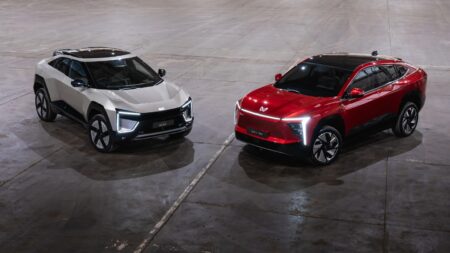According to Audi, energy recuperation will play an increasingly important role in future mobility, including vehicle suspension systems. With this in mind, the company’s engineers are busy developing ‘eROT’, a prototype system in which electromechanical rotary dampers replace the hydraulic dampers used today for a more comfortable ride.
Dr.-Ing. Stefan Knirsch, board member for technical development at Audi explains the principles behind eROT: “Every pothole, every bump, every curve induces kinetic energy in the car. Today’s dampers absorb this energy, which is lost in the form of heat. With the new electromechanical damper system in the 48-volt electrical system, we put this energy to use. It also presents us and our customers with entirely new possibilities for adjusting the suspension.”
The eROT system is intended to respond quickly and with minimal inertia. As an actively controlled suspension, it would adapt to irregularities in the road surface and the driver’s driving style, with a damper characteristic that is virtually freely definable via software.
According to Audi, the damper design would eliminate the mutual dependence of the rebound and compression strokes that limit conventional hydraulic dampers. With eROT, Audi configures the compression stroke to be comfortably soft without compromising the taut damping of the rebound stroke. According to Audi, another advantage of the system is its geometry. The horizontally arranged electric motors in the rear axle area replace the upright telescopic shock absorbers, which allows for additional space in the luggage compartment.
The eROT concept is also claimed to convert the kinetic energy generated during compression and rebound into electricity. To do this, a lever arm absorbs the motion of the wheel carrier and transmits this force via a series of gears to an electric motor, which converts it into electricity. The recuperation output is claimed to be 100-150W on average during testing on German roads – from 3W on a freshly paved freeway to 613W on a rough secondary road. Under customer driving conditions, this would correspond to a CO2 savings of up to three grams per kilometer (4.8g/mi).
The eROT technology is based on a high-output 48V electrical system. As currently configured, its lithium-ion battery offers an energy capacity of 0.5kWh and peak output of 13kW. A DC converter connects the 48V electrical subsystem to the 12V primary electrical system, which includes a high-efficiency, enhanced output generator.
According to Audi, initial test results for the eROT technology are promising, and its use in future Audi production models is certainly plausible. A prerequisite for this is the 48V electrical system, which is a central component of Audi’s electrification strategy. In the next version planned for 2017, the 48V system will serve as the primary electrical system in a new Audi model and feed a high-performance mild hybrid drive, offering potential fuel savings of up to 0.7 liters per 100km.




